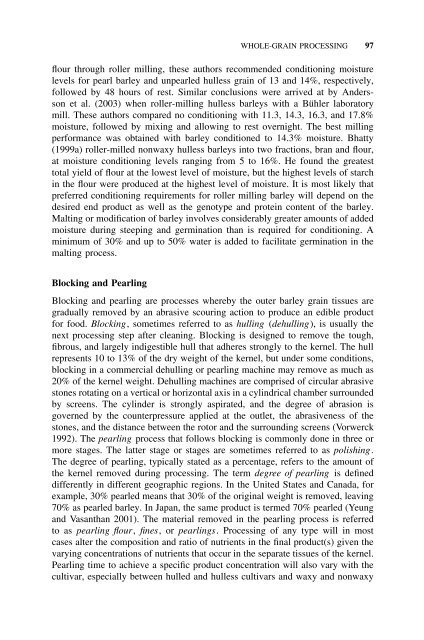Barley for Food and Health: Science, Technology, and Products
Barley for Food and Health: Science, Technology, and Products
Barley for Food and Health: Science, Technology, and Products
You also want an ePaper? Increase the reach of your titles
YUMPU automatically turns print PDFs into web optimized ePapers that Google loves.
WHOLE-GRAIN PROCESSING 97<br />
flour through roller milling, these authors recommended conditioning moisture<br />
levels <strong>for</strong> pearl barley <strong>and</strong> unpearled hulless grain of 13 <strong>and</strong> 14%, respectively,<br />
followed by 48 hours of rest. Similar conclusions were arrived at by Andersson<br />
et al. (2003) when roller-milling hulless barleys with a Bühler laboratory<br />
mill. These authors compared no conditioning with 11.3, 14.3, 16.3, <strong>and</strong> 17.8%<br />
moisture, followed by mixing <strong>and</strong> allowing to rest overnight. The best milling<br />
per<strong>for</strong>mance was obtained with barley conditioned to 14.3% moisture. Bhatty<br />
(1999a) roller-milled nonwaxy hulless barleys into two fractions, bran <strong>and</strong> flour,<br />
at moisture conditioning levels ranging from 5 to 16%. He found the greatest<br />
total yield of flour at the lowest level of moisture, but the highest levels of starch<br />
in the flour were produced at the highest level of moisture. It is most likely that<br />
preferred conditioning requirements <strong>for</strong> roller milling barley will depend on the<br />
desired end product as well as the genotype <strong>and</strong> protein content of the barley.<br />
Malting or modification of barley involves considerably greater amounts of added<br />
moisture during steeping <strong>and</strong> germination than is required <strong>for</strong> conditioning. A<br />
minimum of 30% <strong>and</strong> up to 50% water is added to facilitate germination in the<br />
malting process.<br />
Blocking <strong>and</strong> Pearling<br />
Blocking <strong>and</strong> pearling are processes whereby the outer barley grain tissues are<br />
gradually removed by an abrasive scouring action to produce an edible product<br />
<strong>for</strong> food. Blocking, sometimes referred to as hulling (dehulling), is usually the<br />
next processing step after cleaning. Blocking is designed to remove the tough,<br />
fibrous, <strong>and</strong> largely indigestible hull that adheres strongly to the kernel. The hull<br />
represents 10 to 13% of the dry weight of the kernel, but under some conditions,<br />
blocking in a commercial dehulling or pearling machine may remove as much as<br />
20% of the kernel weight. Dehulling machines are comprised of circular abrasive<br />
stones rotating on a vertical or horizontal axis in a cylindrical chamber surrounded<br />
by screens. The cylinder is strongly aspirated, <strong>and</strong> the degree of abrasion is<br />
governed by the counterpressure applied at the outlet, the abrasiveness of the<br />
stones, <strong>and</strong> the distance between the rotor <strong>and</strong> the surrounding screens (Vorwerck<br />
1992). The pearling process that follows blocking is commonly done in three or<br />
more stages. The latter stage or stages are sometimes referred to as polishing.<br />
The degree of pearling, typically stated as a percentage, refers to the amount of<br />
the kernel removed during processing. The term degree of pearling is defined<br />
differently in different geographic regions. In the United States <strong>and</strong> Canada, <strong>for</strong><br />
example, 30% pearled means that 30% of the original weight is removed, leaving<br />
70% as pearled barley. In Japan, the same product is termed 70% pearled (Yeung<br />
<strong>and</strong> Vasanthan 2001). The material removed in the pearling process is referred<br />
to as pearling flour, fines, orpearlings. Processing of any type will in most<br />
cases alter the composition <strong>and</strong> ratio of nutrients in the final product(s) given the<br />
varying concentrations of nutrients that occur in the separate tissues of the kernel.<br />
Pearling time to achieve a specific product concentration will also vary with the<br />
cultivar, especially between hulled <strong>and</strong> hulless cultivars <strong>and</strong> waxy <strong>and</strong> nonwaxy

















